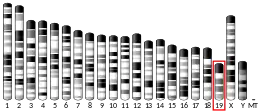| BBS1 | |||||||||||||||||||||||||||||||||||||||||||||||||||
|---|---|---|---|---|---|---|---|---|---|---|---|---|---|---|---|---|---|---|---|---|---|---|---|---|---|---|---|---|---|---|---|---|---|---|---|---|---|---|---|---|---|---|---|---|---|---|---|---|---|---|---|
| Identifiers | |||||||||||||||||||||||||||||||||||||||||||||||||||
| Aliases | BBS1, BBS2L2, Bardet-Biedl syndrome 1 | ||||||||||||||||||||||||||||||||||||||||||||||||||
| External IDs | OMIM: 209901 MGI: 1277215 HomoloGene: 11641 GeneCards: BBS1 | ||||||||||||||||||||||||||||||||||||||||||||||||||
| |||||||||||||||||||||||||||||||||||||||||||||||||||
| |||||||||||||||||||||||||||||||||||||||||||||||||||
| |||||||||||||||||||||||||||||||||||||||||||||||||||
| |||||||||||||||||||||||||||||||||||||||||||||||||||
| |||||||||||||||||||||||||||||||||||||||||||||||||||
| Wikidata | |||||||||||||||||||||||||||||||||||||||||||||||||||
| |||||||||||||||||||||||||||||||||||||||||||||||||||
Bardet–Biedl syndrome 1 protein is a protein that in humans is encoded by the BBS1 gene.[5][6][7] BBS1 is part of the BBSome complex, which required for ciliogenesis. Mutations in this gene have been observed in patients with the major form (type 1) of Bardet–Biedl syndrome.
History
As of 2008, research results indicated that the encoded protein may play a role in eye, limb, cardiac and reproductive system development.[7]
References
- 1 2 3 GRCh38: Ensembl release 89: ENSG00000174483 - Ensembl, May 2017
- 1 2 3 GRCm38: Ensembl release 89: ENSMUSG00000006464 - Ensembl, May 2017
- ↑ "Human PubMed Reference:". National Center for Biotechnology Information, U.S. National Library of Medicine.
- ↑ "Mouse PubMed Reference:". National Center for Biotechnology Information, U.S. National Library of Medicine.
- ↑ Beales PL, Warner AM, Hitman GA, Thakker R, Flinter FA (May 1997). "Bardet–Biedl syndrome: a molecular and phenotypic study of 18 families". J Med Genet. 34 (2): 92–8. doi:10.1136/jmg.34.2.92. PMC 1050859. PMID 9039982.
- ↑ Badano JL, Ansley SJ, Leitch CC, Lewis RA, Lupski JR, Katsanis N (Feb 2003). "Identification of a novel Bardet–Biedl syndrome protein, BBS7, that shares structural features with BBS1 and BBS2". Am J Hum Genet. 72 (3): 650–8. doi:10.1086/368204. PMC 1180240. PMID 12567324.
- 1 2 "Entrez Gene: BBS1 Bardet–Biedl syndrome 1".
External links
External links
- Human BBS1 genome location and BBS1 gene details page in the UCSC Genome Browser.
Further reading
- Katsanis N, Lewis RA, Stockton DW, et al. (2000). "Delineation of the critical interval of Bardet–Biedl syndrome 1 (BBS1) to a small region of 11q13, through linkage and haplotype analysis of 91 pedigrees". Am. J. Hum. Genet. 65 (6): 1672–9. doi:10.1086/302684. PMC 1288378. PMID 10577921.
- Young TL, Woods MO, Parfrey PS, et al. (2000). "A founder effect in the newfoundland population reduces the Bardet–Biedl syndrome I (BBS1) interval to 1 cM". Am. J. Hum. Genet. 65 (6): 1680–7. doi:10.1086/302686. PMC 1288379. PMID 10577922.
- Beales PL, Reid HA, Griffiths MH, et al. (2001). "Renal cancer and malformations in relatives of patients with Bardet-Biedl syndrome". Nephrol. Dial. Transplant. 15 (12): 1977–85. doi:10.1093/ndt/15.12.1977. PMID 11096143.
- Mykytyn K, Nishimura DY, Searby CC, et al. (2002). "Identification of the gene (BBS1) most commonly involved in Bardet–Biedl syndrome, a complex human obesity syndrome". Nat. Genet. 31 (4): 435–8. doi:10.1038/ng935. PMID 12118255. S2CID 29915446.
- Strausberg RL, Feingold EA, Grouse LH, et al. (2003). "Generation and initial analysis of more than 15,000 full-length human and mouse cDNA sequences". Proc. Natl. Acad. Sci. U.S.A. 99 (26): 16899–903. Bibcode:2002PNAS...9916899M. doi:10.1073/pnas.242603899. PMC 139241. PMID 12477932.
- Mykytyn K, Nishimura DY, Searby CC, et al. (2003). "Evaluation of complex inheritance involving the most common Bardet–Biedl syndrome locus (BBS1)". Am. J. Hum. Genet. 72 (2): 429–37. doi:10.1086/346172. PMC 379234. PMID 12524598.
- Beales PL, Badano JL, Ross AJ, et al. (2003). "Genetic interaction of BBS1 mutations with alleles at other BBS loci can result in non-Mendelian Bardet–Biedl syndrome". Am. J. Hum. Genet. 72 (5): 1187–99. doi:10.1086/375178. PMC 1180271. PMID 12677556.
- Badano JL, Kim JC, Hoskins BE, et al. (2003). "Heterozygous mutations in BBS1, BBS2 and BBS6 have a potential epistatic effect on Bardet–Biedl patients with two mutations at a second BBS locus". Hum. Mol. Genet. 12 (14): 1651–9. doi:10.1093/hmg/ddg188. PMID 12837689.
- Ota T, Suzuki Y, Nishikawa T, et al. (2004). "Complete sequencing and characterization of 21,243 full-length human cDNAs". Nat. Genet. 36 (1): 40–5. doi:10.1038/ng1285. PMID 14702039.
- Fan Y, Esmail MA, Ansley SJ, et al. (2004). "Mutations in a member of the Ras superfamily of small GTP-binding proteins causes Bardet–Biedl syndrome". Nat. Genet. 36 (9): 989–93. doi:10.1038/ng1414. PMID 15314642.
- Gerhard DS, Wagner L, Feingold EA, et al. (2004). "The status, quality, and expansion of the NIH full-length cDNA project: the Mammalian Gene Collection (MGC)". Genome Res. 14 (10B): 2121–7. doi:10.1101/gr.2596504. PMC 528928. PMID 15489334.
- Fan Y, Green JS, Ross AJ, et al. (2005). "Linkage disequilibrium mapping in the Newfoundland population: a re-evaluation of the refinement of the Bardet–Biedl syndrome 1 critical interval". Hum. Genet. 116 (1–2): 62–71. doi:10.1007/s00439-004-1184-9. PMID 15517396. S2CID 2305942.
- Azari AA, Aleman TS, Cideciyan AV, et al. (2006). "Retinal disease expression in Bardet–Biedl syndrome-1 (BBS1) is a spectrum from maculopathy to retina-wide degeneration". Invest. Ophthalmol. Vis. Sci. 47 (11): 5004–10. doi:10.1167/iovs.06-0517. PMID 17065520.
This article is issued from Wikipedia. The text is licensed under Creative Commons - Attribution - Sharealike. Additional terms may apply for the media files.



